|
2023.11.11
Оказывается танцы — это сурдоперевод музыки...
It turns out that dancing is sign language translation of music...
2023.11.10
One more, six style of tango! I forgot that I have met it 20 years ago. Tango Liso!!! (Smooth Tango).
But only now I feel I can masterfully perform it..
2023.03.31
From now on!!
Classical-dance Tango and Salsa-Tango
Classical tango - the root of everything! Fusion of Salsa and Tango: Salsa gusto and body energy to tango rhythm, rhythmic music, and figures. And occasional tango to Latin. From now on.. Back to roots!
From your local beloved tango partner Igor Polk
Love it!
(Based on Cuban latin body technique)
Also, by request, flamenco-tango, classical-dance-tango, and other Argentine Tango styles: Canyengue, Orillero, Salon, Apilado, Nuevo. Find in what they are different technically(!)
2023.03.05
Energies and playfulness,
Energies give meaning and musicality to dance. Actually, interplay of energies creates the dance.
Most people mistake movement for energy. It is not so. If there are too many movements it does not mean there are energies of the body there: when we walk we mostly use energy of Earth gravitation, not the energies of body. On the contrary, when a body possesses and uses energies, it does not mean there are a lot of movements - and that is the main characteristic of dance, and, in particularly, tango. No energies - no dance.
Energies of human body create rhythm. One cannot be rhythmical or musical if there are no energies.
Reviewing all the energies available and learn how to variate all familiar elements is the topic of the next class.
What energies are available (in order of importance): energy of mid of torso at the solar plexus level, multiple energies of pelvis area, shoulder girdle torso area, rotation of hips, three levels of freedom in arms rotations (torque!).
2021.07.07
Профессор Гарвардского университета Эми Кадди провела исследование языка тела и его влияния на уровень стресса и стероидных гормонов в нашем организме. Главный сюрприз - это скорость, с которой уровень гормонов может повышаться или понижаться. В ходе исследования она сравнила различия в уровнях гормонов между двумя группами, одна из которых приняла так называемую мощную позу (занимающая больше места, широкая стойка, руки за голову) и вторая так называемая поза малой мощности (скрещенные ноги, занимающая меньше места, неуверенная поза, склоненная голова). Всего через две минуты исследователи заметили увеличение тестостерона на 20% и снижение уровня гормона стресса кортизола на 25% в первой группе (мощная поза). Вторая группа зафиксировала противоположные результаты. У них снизился уровень тестостерона и повысился кортизол.
Translation: More of good tango postures - more testosterone - much more defense against COVID! There is a direct relation between low testosterone and 6 times more risk of death from COVID (in men)!!!
2 minutes of a great posture (ask me) - 20% increase. Sex increases testosterone by 75%.
2021.04.15
I have no more questions about origins of tango:
https://youtu.be/e6wf9RH07F8 ( folk dancing from Latin America )
https://youtu.be/8lpr-jhbskw
And here where it goes:
https://youtu.be/sQ2chcGOJgY ( Roland Petit, Bolero )
2020:
Polish dance: https://www.youtube.com/watch?v=dz8QBOfnxc0; Useful for tango. (Bulgarian and Pamir dances are cool too )
============================
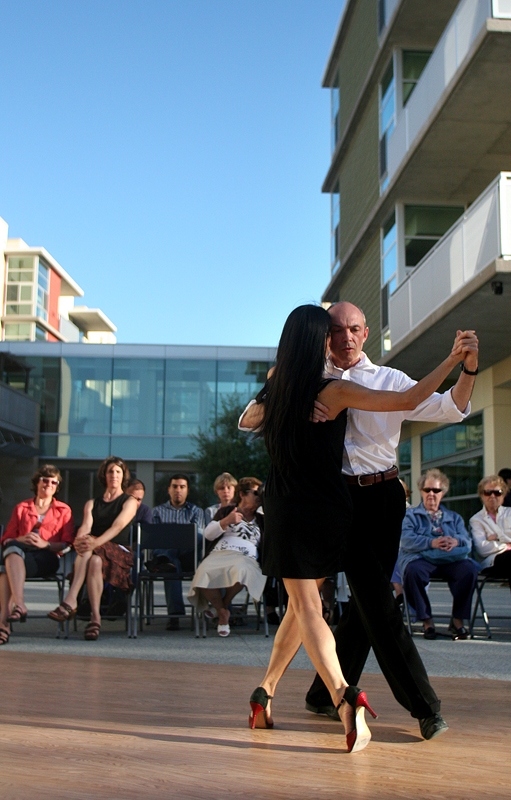 https://www.paloaltoonline.com/news/2010/06/21/dancing-the-night-away https://www.paloaltoonline.com/news/2010/06/21/dancing-the-night-away
2020.08.12
Photos from 2013 when we gave a little lecture and danced for doctors.
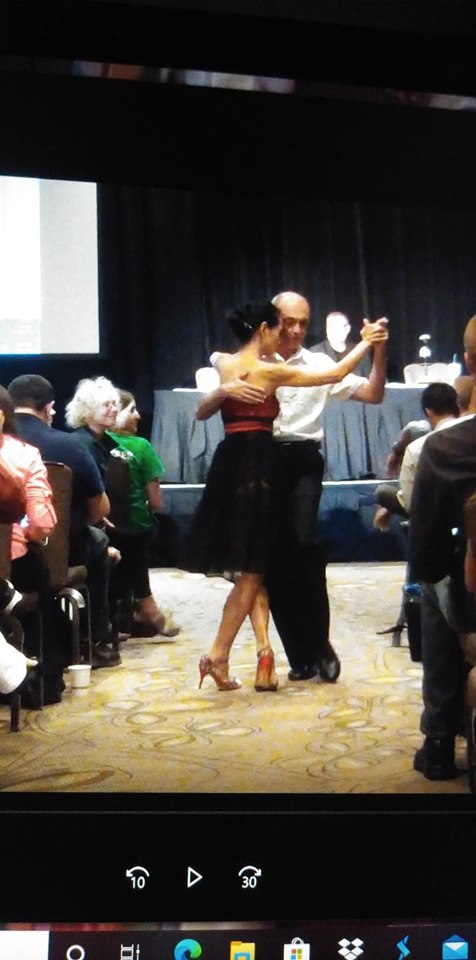
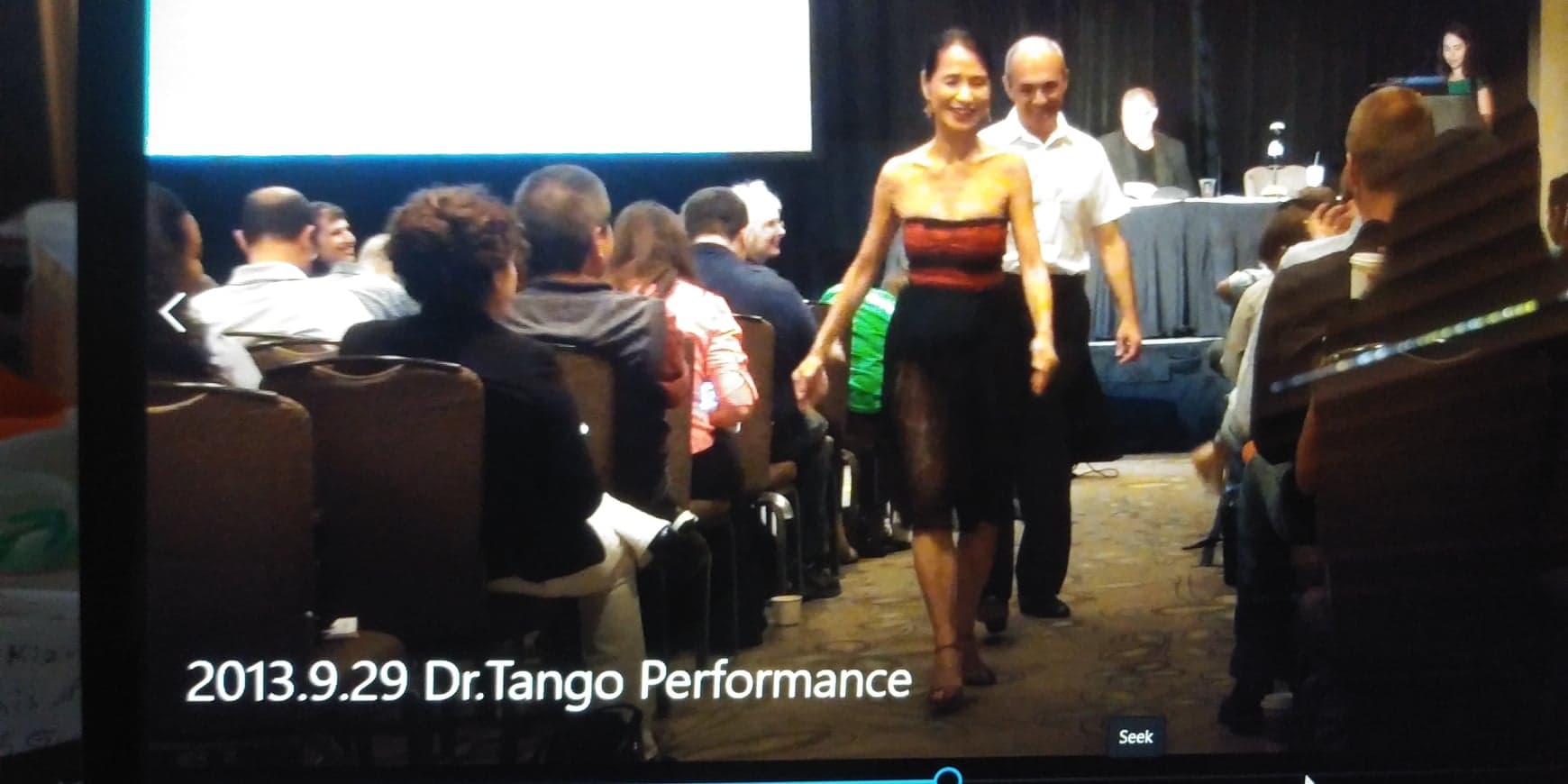
2020.04.21
 Mayumix Botanical Design featuring botanical printed (or eco printed) scarves. "Botanical printing is done by placing real leaf and plants on top of white silk, rolling it up and steaming it for 2 hours. The end result is like a painting or photographing image of real plants onto fiber." - from a wonderful dancer Mayumi ! Mayumix Botanical Design featuring botanical printed (or eco printed) scarves. "Botanical printing is done by placing real leaf and plants on top of white silk, rolling it up and steaming it for 2 hours. The end result is like a painting or photographing image of real plants onto fiber." - from a wonderful dancer Mayumi !
2020.07.30
Should I use a short step or a long step when I walk in the tango?
There are three kinds of steps, but they are not distinguished by their length.
All of them can be short or long depending on situation, creative idea, and amount of energy you give to them.
1. Short step as if going steep down-hill. It can be done forward or backward or even side. If forward, keep the knees together.
This is essential. Technique: first charge your body. If a man does it, it is the lead.
Then the leg is extended gently (you do not know how steep is the down-hill, do you?) and then the step itself is performed gently.
When the weigh is transferred, the body is in the neutral state.
So the body goes from charged to neutral. After the step, feet are together.
2. The step up-hill. It can be very short or very long.
Usually it is done side. But also forward and even backward.
Technique: from the neutral position of the body step right away propelling your body with the energy
of your pelvis and legs as if you go steep up-hill. Again, it can be very short or very long.
You end up in the body charged state (ready for boleo or else). So the body goes from neutral to charged.
This step is twice as fast as the Short step down-hill. After the step, the trailing leg is extended.
Think about it as receiving gancho.
3. A combination. You start with 1, but when the leg is extended, charge into 2.
The combination (i.e. 2) does not necessarily long!!! It can be short as well, that is the Mastery!
The most typical tango step is 3. But 1 is very important, especially in salon, milonguero, and apilado styles.
It is difficult to do. 2 Is also important, especially for social dancing, Nuevo, and show.
Unfortunately, most beginners step only in the 2-nd way, that is very bad.
The short step is the most difficult. Men especially must master it,
since women's steps are usually smaller and men must be doing harder work adjusting.
Practicing all this steps in all directions is a paramount. In order to understand them, try to do boleos and ganchos,
all sorts of them for 1: before the step after the stepping leg is extended, for 2 and 3: after the step when the trailing leg is extended.
Understanding that there are three kinds of steps is the way to success in tango. The only way. Think about sacadas..
What I described here is only a small fraction of the theory of steps.
The complete theory to the last detail is described in my book "Twist Forms. Dance Theory of Argentine Tango", by Igor Polkovnikov (Igor Polk).
I welcome everyone to my classes in Palo Alto to learn it no matter what your level is.
This is the key to your progress. Even if you are a performer (I do watch you all).
2020.07.25
How to lead?
To understand what is the perfect lead, one has to understand what is the perfect following.
There are 4 cases. Assuming that the man is a perfect dancer.
1. The woman is a perfect dancer;
2. The woman is ok-dancer;
3. The woman does not know tango much, but has good abilities and body;
4. The woman is a poor dancer and does not have abilities.
3. and 4. The man does not lead them. He manipulates them provoking them to a certain action, pushing and pulling them if needed, and adjusting to the results.
Every master inevitably knows how to do it. Unfortunately, many thinks this is good, or even a good lead. But it is not. It is manipulation.
With 3 he enjoys the dance, with 4 - struggles, but nevertheless the dance works somehow.
Surprisingly, one of the easiest figures (after "corte y quebrada") to lead an inexperienced woman to is a turn.
1. Here is the essence of dancing. The woman understands how to dance. What does it mean? It means that before performing any element she prepares. SHE PREPARES!!!
It means she sets up her body in a Certain Energetic Configuration, so that she is able to perform the element starting from that configuration.
If a man wants to lead this element, he must set up his body in such a way that
if his follower mimics him by matching her torso and pelvis areas of the body, and embrace to his, she appears in that Certain Energetic Configuration.
And then both of them perform what is needed, obviously adjusting to each other. This is a simplistic explanation.
For the much more complete theory, please, refer to my book "Twist Forms. A Dance Theory of Argentine Tango" where all secrets are explained to the subtlest detail.
Needless to say that the perfect "following" dancer is able to influence her able partner in such a way that He Leads Her to What She Wants. And this is not a figure of speech.
2. When the woman is ok-dancer, she may know a lot and her body does go through those Certain Energetic Configurations, only it may happen not to the man's desire.
Then he is capable to catching up with her and then it appears that she follows very well, when in fact she may not follow at all.
With a healthy dose of manipulation the man may make a perfectly felt dance.
The man, knowing how her body should be, can even SHAPE HER BODY to that Certain Energetic Configuration by subtly shaping her torso
and pelvis orientations with his arms, torso, pelvis, and manipulation skills.
Concluding. A man can convey his intention only if he knows exactly what she should do. And the dance works only if he knows how to adjust to her reactions.
All that means that the good leader has to be a perfect follower himself.
2020.07.15
"
Will you have the same improvements if you take online dance lessons instead of normal dance lessons?
"
I do not believe so. I even think that buying a video tape and studying it is better than an on-line lesson, because of the completeness of material in one place.
Obviously, practicing whatever is useful, but of little importance to good Argentine Tango dancing, when the main challenge is to dance with a partner.
As an exercise without a partner, I would recommend classical ballet rather than anything else.
This will really improve you. Also, I would sincerely recommend exercises from my book “Twist Forms”.
24 ways of pivoting and many other things will take you months to study.
My other exercises are about dance structure, rhythms, and body energies (similar to ballet).
I am confident that it is the most useful practice you can ever get. Sorry, no video available.
You can order the book from Amazon.
In general, especially in relation to Argentine tango, it is very important to watch how dancers dance,
because, as I have found, they dance not in the same way they explain or show.
2020.06.17
"Are back ochos done with or without pivoting?"
There are 2 pairs of options:
1) with pivoting and without pivoting;
2) by twisting the pelvis toward the partner and by not when the pelvis does not face the partner after the pivot.
Ocho without pivoting is done by rotating the leg which goes back toward the partner so that its toe is directed exactly toward the partner's torso center.
Pelvis is obviously twisting toward the partner. This is an older style attributed to Canyengue. Some modern Milonguero dancers use it.
The same can be done in open and close embrace. Slight pivoting may be needed for extra adjustment. This method allows dancing on concrete!
It is a difficult but extremely useful technique. One has to learn.
Ocho with pivoting is done, well, with pivoting. Refer to my article "24 ways of pivoting" to get the abundance of techniques.
The main are: pivoting mostly with torso energy - Salon style; pivoting mostly with pelvis energy - Orillero and Nuevo style.
When pelvis is twisted toward the partner during the back pivot (read it carefully: pivot is back, but pelvis is turning TOWARD the partner)
the amazing energy is accumulated. It is for both Salon and Orillero. It allows dance to be more compact fitting a crowded dance floor.
This can be done in open and in close embrace.
A woman does it, but this technique is the must for a man who does it a lot as well.
When the pivoting ocho is done without turning pelvis toward the partner, but keeping it as is, that brings it away.
It is possible only in open embrace and is not suitable for crowded dance floor. It is Nuevo style.
The position after the ocho allows some specific elements of Nuevo style but it does not have gusto of good Salon and Orillero.
This is easy to do because it does not require any special training. It just happens.
Nuevo style has a lot of deep pivoting which feels good.
Mastering back pivots and especially a step after the back pivot is very important in performing good Argentine tango turns.
Many dancers are unable to make a step after the back pivot, this is a luck of technique.
A versatile dancer can do everything.
2020.06.17
"Why do the best and most famous South American tango dancers tend to be older couples?"
I do not think so. Many young dancers as well as old dancers are vary famous. Many are great and many just use unknowledgeable public.
Nowadays “older couples” were very young just recently. Time flies. Really old couples, who witnessed the tango hype in 1940 (not to speak earlier) all passed away.
When Argentine Tango started in around 1990, many famous dancers were young. Now they are old. Paradox?
In fact the most popular couple in the world ever in tango history, Carlos Gavito and Marcela Duran portrayed old and young image.
Not that old. Carlos Gavito was a professional dancer on pop stage.. He only looked old.
What is good about Argentine tango is that it allows progress to a very old age. Experience is accumulated and it is not lost.
That is probably why older couples are always somewhat better.
2020.05.30
"Should one be light on the feet while dancing tango? What can someone do to be lighter on the feet?"
Of course. He should! Especially a man.
As a definition of “to be light on their feet” I take this: “A man who is “light on his feet” isn't necessarily fast moving, but can change directions quickly and float across a room without effort”. It really means to be smooth, agile and have great reaction. More important to say what it does not mean. You still have to maintain perfect leading and following skill and obey the correct tango rhythm: syncopa. It means not to forget to make a longer pause on every 4th beat, and a small one on every 2-nd.
In tango it is important to have “static energy” - energy of muscles preparing for the move, or moving slowly with effort. If one does not have the static energy, it does not feel right. But it does not mean one should not be “light on their feet”. It is different. He should!
To be "light on their feet" one has to be able to use pelvis muscles well. Torso is very important too. All body energies work together.
In addition, arrepentida (corte, rebound) has to be masterful. Practice faster Cunita and Corte-y-Quebrada with change of direction.
2020.05.14
"In the tango, how does the follower know when the leader wants to shift his weight?"
There are three situations:
1). When the leader wants her to transmit the center of gravity to another foot, and change foot himself or not;
2). When the leader does NOT want her to transmit her wegith, but to stay on the same leg.
The leader may want to change his foot or step;
3). When the leader "shifts his weight" without attention to the follower.
Let us consider it:
1).
The leader must lead her to transimit the weight or make a step (side one is the most simple). It is done in two ways:
1.a) - the leader LEADS her to the side step. "Shifting of the weight" to the side direction is nothing but a small
side step. He leads in this way: stretching his torso center to the side. While doing so, he does not step! Then she shifts the weight.
Then he feels it, he shifts his weight (or not) as the reaction to her action.
1.b) - the leader LEADS her to the side step around him by rotating slightly around his own vertical axis. As much as needed.
He must stop when he feels she has finished transferring her weight.
2). He does not want her to transmit weight. He must make sure that there is NO LEAD.
It means his torso does not do anything to be felt like in 1). It requires practice and precision.
If he wants to step himself, he can go around HER axis. Still it should be NO LEAD. That will become Calesita.
3). Good leaders cannot afford it. When a bad leader does it, there are two situations depending on the follower:
3.1). If she is experienced, she can feel it somehow and adopt. Few can do it and no one likes it.
3.2). She is not experienced. She may do whatever...or nothing. There is no connection, therefore, there is nothing good about it.
2020.05.14
What is the meaning of ‘it takes two to tango'?
In quality Argentine Tango the most important is “conversation” between partners. That what makes the dance.
If there is no conversation the dance is of low quality. Conversation requires two participants that is “it take two to tango”.
What “conversation” means? The man leads. The woman feels the lead and performs.
When doing so she is waitching for his raction. He reacts. Then it starts over.
2020.05.11
" Is it better to learn the tango by taking dance classes or by dancing at the milongas? "
This is not an easy question. It depends who you are.
I was taking classes before came to a milonga. Almost every day. I was driving 45 minutes to get to a class after work and back.
I tried my first dances at practicas where my clumsiness would affect no one. That was tough.
But soon it paid off. Because I am talented and I had a lot of prior training I have learned how to navigate quickly and started to go to milongas in 6 months (remember, everyday lessons, sometimes several!).
I was trying to show my great navigation by dancing at the very edge of the floor. No one noticed. Real training comes at milongas, in the real dance. That is where you actually learn.
But not before you are able to navigate in the crowd. If you can't, you can do nothing, and only are an obstacle for the more advanced dancers.
That what classes should be for: to prepare physical abilities and navigation skills. Coming back to my experience… I was going to a milonga almost every day.
I always took a pre-milonga class. I started dancing at the very first dance and left the last after Cumparsita. I did it for many years..
Not everyone can learn at milongas: you have to have a set of mind to do everything better and better, improvise trying something new, have great reaction to fix mistakes so that your partner does not notices,
have great feeling of the partner. After milonga you have to have the feeling of progress and achievement: I did something better, I did something new.
One has to have a spirit of learnig. If so, he will succeed. I as a teacher feel it in the students and act accordingly.
For women it is different than for men. While for men navigation is the upmost skill, for women it is technique. She must learn to move like in tango. No one can do it in milongas: tango is too unusual.
I was able to learn to move right, because I have danced with great women-dancers and they have shown me what they would want. And I was able to catch up. Classes for women should concentrate on technique.
Other important things which classes should address besides the right technique and navigation, it is feeling of the partner and correct tango rhythm and phrasing. But all that can be sharpened only on the actual dance floor with the large variety of partners.
The third very important method of learning is to watch videos of great OLD MASTERS! (not young !!! and not of those who look old now.). I can not emphasize this more.
On these videos you are able to understand what tango dance is, how to dance it, and watching the same again and again (20 times?), and then trying it at milongas.
I have collected a huge collection of videos at me first months of learning. And that helped my tremendously. You are at disadvantage now. Those videos are gone! And youtube is too hectic to find gems.
Shortly: classes are to prepare for milongas where you actually will learn, but you cannot learn at milongas if you do not take classes. Especially women. Watching videos of great old masters is essential.
2020.04.21
Geraldin Rojas y Ezequiel Paludi
2020.02.12
This dance is in my collection for long time: Cuban "Tango" - Son

and Tango Vals by
Ariadna Naveira & Fernando Sanchez (!)
2020.02.10
Ivan Terrazas y Sara Grdan tango with a lot of Colgadas.
2020.02.05
I'd like to attract your attention to my work which describes improvisation in terms of possible body movements and allows automatic generation of dance. It is called "Twist Forms. Dance Theory of Argentine Tango". You will find it on the internet. It is a significant description of what spaces an improvisational dancer may exist (there are six). I approach dance not from visual perspective, but internally where the visual is only the result of what is happening inside the dancers body. The simples internal dance elements can be combined naturally into more and more complex figures which no artist can imagine. In performances, it is very visible when dance is choreographed "from outside" or "from inside". The second wins though judges may not be aware why. Improvisation is choreography "from inside".
When two persons interact in the dance, it allows their following and commanding each other. With the notion of natural movement, it become harmonious and infinitely interesting. The number of options is so large (six spaces!) than no dance can be the same. Since we now know the mechanisms of it, they are described in the book, we can make an automated dance which will have qualities as the best choreographic works.
Please, take seriously what I am talking about. We can make great artificial dances not with cylinders, but perfectly emulating human body.
2020.01.22 (nice date)
In my tango theory "structure" relates to the form of the figures.
When I am talking about "X-pattern generator " that was about structure.
Shortly about what steps comes after what element, and what elements is possible to be performed after what.
This is a narrow definition. Each of the main dance areas: movements, energy, rhythm, space, interaction, and the abovementioned narrow "structure" has its own structure, and even rhythm!
For example, rhythm of energy is not the same as the rhythm of steps and music, or even interaction (lead-follow). Or, rather, may not be the same.
2019.12.15
Here is the video of one of the most knowledgeable researchers and performers of authentic tango, Pocho Pizarro:
https://www.youtube.com/watch?v=UFCA3vtHhfU
"What is forward and backward tango walk". If you ask me how is it possible to walk like this in couple or what figures this kind of walk produces, come to our classes.
This is a great illustration to Igor's tango book "Twist Forms". Or rather, this book was written under influence from Pocho, since Igor is his student.
2019.07.22
Sent: Monday, July 22, 2019 06:52
To: webmaster@virtuar.com
Subject: Tango nuevo versus Neo
Hello igor,
I read your article:
http://www.virtuar.com/tango/articles/2005/nuevo_neo.htm
I was wondering did you ever revise this article in the end? Do you still share the same opinion as that time or new visions ?
***
No, I did not revise it since it was updated the last time.
A lot of time passed. I have changed: I wrote a large book on dance technique and became popular tango teacher. I believe I know about tango and dance much more than 10 years ago.
I re-read the article.
I still share the same opinion and sign under any word of it. I am even surprised that I nailed it all right.
I'll tell you about the major technique difference in Neo. It originated in Nuevo style and has developed in Neo.
In all styles of Argentine Tango ( danced correctly) pelvis of a woman ( and a man) must (MUST !!!) be directed toward the partner ALL THE TIME! It generates oscillating torques in the body. This is one of the things which defines the dance. Obviously, all other elements depend on this very important feature: molinetes, boleos, ganchos, even steps, etc.. By the way, it allows much more compact dance on the social dance floor. Together with deep pivots and rotation of a hip inside, that is a key to be able to dance on the same spot.
In Neo, as a rule, the pelvis of a woman is rotated AWAY from the partner. That makes all elements: boleos, etc. be performed it a totally opposite way. This is an easy way for westerners, since that how it is danced in ballroom, latin, modern. Authentic tango way, when the pelvis is TOWARD the partner is difficult to achieve. It is very specific. So, I guess, why bother...
Unfortunately, many of younger generations of tango pretending to dance salon or orillero, have no idea about it. They are professional dancers which came from Modern and Ballet (and may be hip-hop). So, the pelvis AWAY has sneaked in performances of people who claim they dance real tango.
If you never experienced how to dance with pelvis toward the partner, you most definitely will not understand what I am talking about. Try it. It is difficult and feels contra-intuitive at first. But once you know it, you would not want anything else.
Besides, it is good for martial arts..
2019.07.14 Someone asked my, why have I written the book, if there is so much material available on the internet in written and video form.
The next night, after I wrote what is below, I had a dream. A woman wrote a book about tango and she was asked "Why?".
She answered: "Easier to understand". She is so much smarter than me!
So, the previous answer.
1). You do not see how dancers body moves or acts. Especially man's who dances tango in a jacket.
Even if you see it, you will not be able to recognize what is happening inside the dancing bodies:
you will understand it only (only!) when your body starts to make it.
My task is to explain how body works in a most advanced way so that by trying it the way it is written, you will get it eventually.
2). There is so much in tango, it is extremely rich movement activity. Besides everyone speaks about it differently.
Besides, most teachers and dancers only value their own way of teaching and moving.
So more or less complete explanation is only possible in the book.
3). I give you the deepest secrets of body action.
You will not be able to find it all, or if you try, you may spend as many years as me, say 20.
Or buy the book and study it. It does not cover all the tango, but well over 100 private lessons.
4). While writing the book in a mathematical way, like mine, which makes it a valid scientific theory,
you are obliged to strive for completeness and perfection, and make everything logical and matching. One thing has to come from another.
And all of them - from the natural movement of highly advanced body.
Making the complete theory and, especially, finding the language to describe it is very difficult.
So, if there is a book, there is a scientific theory, if there is no book, there is no theory.
And science is truth, isn't it?
I am here, in Palo Alto. Every Monday. Come and try it for yourself. $15 for 2 hours. Almost free.
2019.07.06 ( year.month.day, this is much more logical and convenient)
The letter from a friend:
This story all begins with me first year at UCLA. I met a yogi who was in the dance department. He taught a yoga class before our technique class that I went too. He took me to a book store that is very famous in LA called The Bodi Tree Book Store. There he turned me on to Inayat Khan's books on Music and education which I still have and keep. I used these books for research papers at school. So this yogi guy turned me on to the Sufi's which I did not connect with until 6 years later.
Then at UCLA about 2 years later comes a special teacher whose name was Jack Cole. I went to one of his classes and I think this brought out something energetically in me that got more cultivated with Lucas. Anyway, this class had been going on for a while before I walked class. The only spot to take was directly behind Jack. He was teaching something that just spoke to me and have not found in any other dance teacher accept Lucas. He was teaching energy. He turned around and said finally, someone here has what I mean. He looked at me and said, it was you and I said yes. I knew that the one thing he was talking about none of the other dancers had or understood. But he knew it was me and I knew he knew before he said anything. This energetic thing came from reading Inayat Khan's book.
So I was thinking that my tango teacher Igor, is built like Jack Cole and about the height. Igor likes isolations and he is the only tango teacher that teaches this way. I wonder where Igor learned the way he dances. Or what his teachers background is? Argentina and the Carribean are not that far away from each other. This caused me to do some research on Jack Cole. He actually was the person that brought hip, neck rib isolations to dance.
Jack Cole was the youngest and last member of the Dennis Shawn company an later danced with Doris Humphrey and Charles Weidman. You know that Jose most likely danced or knew Jack Cole. He came to Dennis Shawn without any dance background and Jack became the largest influence in Stage Jazz Dance. He brought the whole concept of "energy" on to the stage. Ruth St. Dennis studied intensely with the Sufi Murshid Inayat Khan Indian dance and music who was the most famous Indian musician of his time.. I think his transmission of spiritual energy was a very big influence on Ruth St. Dennis, hence on the world of Modern Dance.
Jack Cole had a group of dancers in Hollywood who he trained. His training contained: Modern Dance, Afro Haitian and Indian Dance. He was always concentrating on projecting energy. All these stage dancers had to study Modern Dance. Here is another place where the Modern Dance world influenced the dance world.
This energy to project is transmitted from Inayat Khan to Ruth St. Dennis to Jack Cole and Martha Grahm both students of Ruth St. Dennis. Then most likely Jack Cole to Doris Humphrey to Jose Limon to Lucas Hoving. I am amazed of my findings about Jack Cole and the whole Modern Dance experience. How many times did you see Lucas take his hands and his burning blue eyes that would look up at the class and demand that we dance with energy?
The Sufi's actually have spoken about the 2 founders of Modern Dance. The connection between Ruth St. Dennis and Inayat Khan made her dancers keep working and growing and still thriving. The Other founder, Isadora Duncan who did not leave a legacy. At least on the level of Ruth St. Dennis. This is very powerful knowledge. Ruth St, Dennis got the name of St. because of her working with Inayat Khan.
Because Ruth St. Dennis's infatuation with Asian, and Indian dance, Jack was exposed and studied these dance forms where he got and used the isolations of the neck and hips: Influences of Ruth St. Dennis and Katherine Dunham who was the Modern Dancer that studied Carribean dance and fused it into the Modern Dance world.
He was the choreographer for "Diamonds are a girls best friend" and was behind the camera when Marilyn Monroe recored this dance piece. He stood behind the camera and kept telling her to "give it to him." "It" meaning energy. Every move she made, she had to give it with engergy. She really praised him for his work with her.
He made Rita Hayworth, Betty Grable, Chita Rivera, Gwen Verdon and many more excellent dancers. Gwen Verdon was married and worked with Bobbe Fosse. I think this is the influence of Jack Cole because Gwen was his main dancer and rehearsal assistant. Gwen could get his ideas across to the performer. I am more than sure that she also got Jack Cole's ideas across to Bobbe Fosse.
He took his Modern Dance background with Ruth St. Dennis/Ted Shawn, Doris Humphrey/Charles Weidman and fused it with East Indies dance and put it on Broadway. He brough the body isolations & energy on to Stage dance. He is now called the "Father of Jazz Dance." He influenced Jerome Robbins, Bob Fosse, Michael Bennet and other great Jazz choreographers. No wonder these choreographers are considered a bridge between Jazz and Modern dance. He also influenced Alvin Ailey. This is big.
There was an interview of a dancer that worked with Jack. She called him the dancer's teacher or the dancer's teacher.
To top all this off, I told Lucas that I had taken this class with Jack Cole and what happened there. Lucas told me that he was jealous because he never got to take a class or work with Jack Cole. Lucas told me that Jack was his idle because he had so much energy when he danced. What did I know. I was both of their students. I always wanted to dance with teachers that understand energy behind dance. All Arts have a direct connection to Love and the great Spirit. I love technique ony to have a good foundation to express spirit energy. It has always been my thing.
There are only a few people in this world that would understand the far reachings of Inayat Khan. There is a Sufi woman who I taught some dance class that I took and she told me that the relationship between Murshid Sam and Ruth St. Dennis was very close to getting married. They were both students of Inayat Khan. One brought his energy through dance on to the stage in many ways and the other brought his dance into the spiritual world AKA "Sufi Dancing." I think both are very connected.
Anyway, I see dance as well as Art in general as a spiritual vehicles to reach people in expression. I think that great artists like Ruth St. Dennis and Jack Cole knew this also on some level. Look at Lucas and his wife, one studied with a Hindu guru and the other with a Buddhist Roshi. I think this is why Lucas was driven to want to work with Jack Cole.
Here is a video of many people speaking about Jack Cole and one person said it was almost working with God.
Through all my research and writing, I am trying to pack but I could not ignore what I found and wanted to pass it on to you.
P.S. Enjoy this video
https://youtu.be/bd_tuhzvsD8
2019.03.04
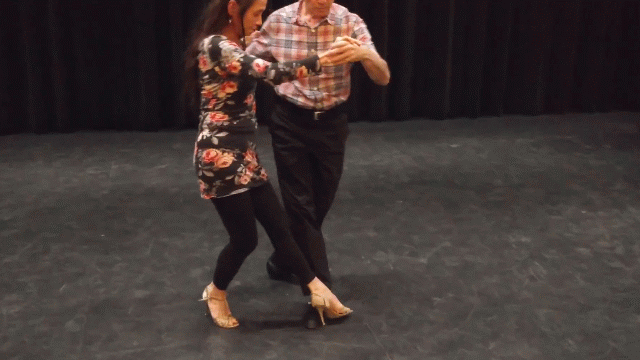
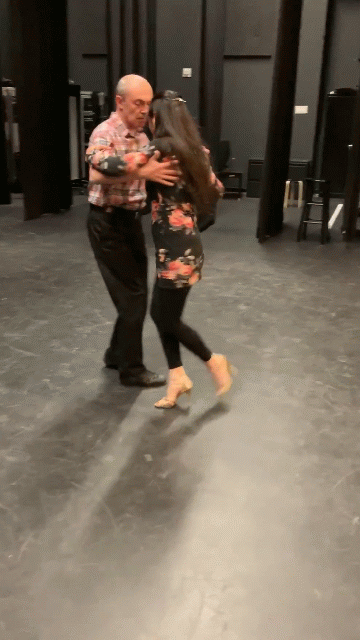
2018.12.19
For the full video: https://photos.app.goo.gl/RzgpFyJZRHwbVLSaA
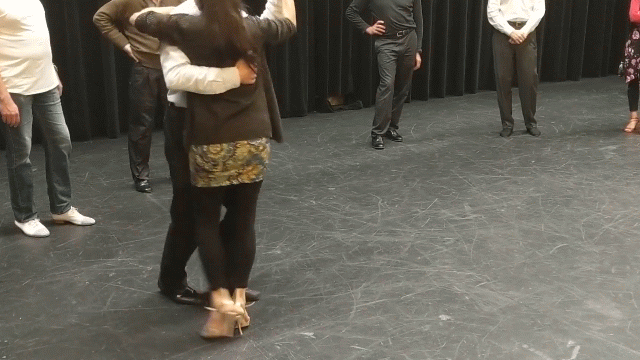
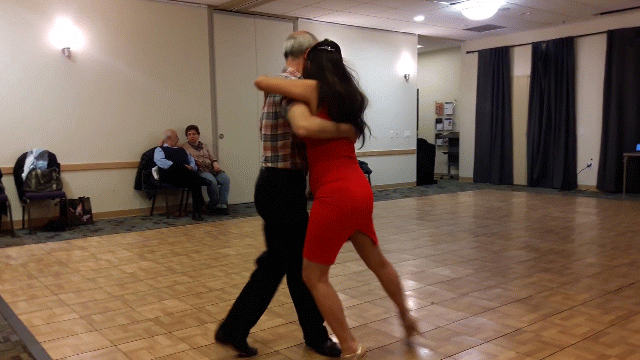
2018.11.05
Please, review some great dances:
1.
Osvaldo Zotto (passed away) and Lorena Ermocida: Salon Style.
http://www.youtube.com/embed/7W5hbx1yG28
You may find their movement rhythm "off the beat". That is correct. They dance to the true "syncopa" tango rhythm. Once you sing it in your mind - they become perfect.
2.
An european couple dances in Tango Nuevo style:
http://www.youtube.com/embed/ocrFY-ZPd7w
3.
Gloria y Eduardo Arquimbau 2003 - Tango-milonga (Canyengue, an ancient style)
http://www.youtube.com/embed/sCC80q6-7g4?rel=0
4.
Alberto Dassieu (passed away) and Elba Biscay - Tango Vals . Apilado style:
https://www.youtube.com/watch?v=orgGazxNz64
5.
Roberto Herrera y Tamara Bisceglia, 2007. Tango Orillero style. Their elements are not newly made. They are authentic and ancient. Enjoy!
https://www.youtube.com/watch?v=Xnolxp0YgdA ("El Lloron")
2018.10.10
Argentine Tango danced by Anthony Dexter and Patricia Medina in Valentino (1951).
2018 July 25
An article by Sasan Rahmatian on "The Structure of Argentine tango" is published in the Journal of Mathematics and the Arts.
The author proposes and discusses a mathematic model of tango steps. What I like about it, he addresses the quality of tango steps.
That is quite unusual for the existing literature on the subject. Though the model is different than mine, I have found the publication is useful for my personal research.
2018 July 3
If you have difficulty performing what is taught in a dance class, here is my advise:
The real problem is in your body not being able to execute what is proposed. Any verbal explanations will not help it. Do not spend your time and money on private classes. Without much words, as a trainer, I'd like to tell you what can progress you forward at this point of your dancing carrier.
You have to exercise more. I recommend running including up and down hills forward and backward. Not jogging, but running with maximal power and speed. Short time, that is fine, it does not have to be tiring. 2 times a week is enough. Fast and energetic walking is also good.
And push-ups to develop flexible embrace. For correct posture, the hands should be on the level of solar plexus. All this can be amended with a healthy dose of other simple exercises, preferably from gymnastics, at your discretion.
More than anything else, I recommend Chinese gymnastics with swords.
From tango: forward ochos and women's part of Ocho Cortado. Do not wait, start now. It is a slow process. But you will be very satisfied in 6 months.
2018 June 28
Dancing engages and changes the brain in unique ways.
"Hong Kong ballet" by Dean Alexander.
2018 May 27
What are the good qualities of Tango followers?
1. First of all, you have to be a good dancer. Your body have to be well developed, you should be able to twist your body, be able to make beautiful figures with arms, feel free on the dance floor, be very musical: to feel the music and be able to express it in your body(!!!) and steps. This is the most important advice. Good dancers differ from the rest in how they move, especially body, quality of movement. Some lucky ones have it naturally, others - have to work hard on that.
2. Second, you have to be able to feel your partners. Your attention should be on him all the time. You, ladies, are the dancers but you dance to be able to stay with a man. It is a specific Argentine Tango skill, very difficult to obtain. Trained, professional(!!!) dancers may not have it at all! They still have to struggle like everyone else.
2.2 Of course, it relates to excellent leaders mostly. There are very few of them. What is an excellent leader? The one which directs and supports the dance feeling inside his woman. Perfectly. If you do not have the dance feelings, and specifically, Argentine Tango feeling, you should develop one.
3. Thirdly. There are not that many men which are excellent. They are musical enough and lead nicely, but without much knowledge and feel of the partner. "Nicely" means they do not make anything "bad" to woman's dance feelings. To dance with such men is easy and pleasant, but if you know the dance yourself. So, the third quality means a good follower should know the Argentine Tango styles and vocabularly. And you will be fine! Dancing in open embrace may be easier with such men, than in close embrace.
4. Forth. There are beginner men (who think they are not). Majority of all men-dancers like that. Good followers do not dance with them, period. But sometimes you would want to dance with such man, just because of other social reasons. To make it successful, you have to be very, I mean VERY, strong and knowlegeble about the dance. It is possible, but very hard.
To be an ok follower is easy. To be and excellent follower requires a lot of skills and knowledge. Good luck in obtaining them!
5. PS. An advice on taking the classes:
1. Take privates with men, not women. Men know much better, how the woman should dance.
2. "Woman's technique classes" are not that useful. You will be better off doing gymnastics, ballet, modern, jazz, maritial arts, heavy weight lifting (no kidding), soccer, running cross-coutry, and so on. Those class, being useful somewhat, introduce many very bad habits, the most awful of which is not be able to listen to a man while doing "adorments" on your own. On the other hand tango technic is abundant: there are 24 ways of pivoting! And you should know at least 12.
3. Learn all styles, it will greatly improve your vocabularly, skills and abilities. The must-styles are: Salon, Orillero, Nuevo, Milonguero, Apilado, Canyengue. All of them!
2018 May 16
About the embrace during HER pivoting.
I am afraid I may discourage some of you. "doesn't prevent her from pivoting by squeezing hard" has double meaning. Under this phrase, some people understand that during pivoting she can detach from him with the result of moving her very upper torso away. This is possible, but it is not perfect. The perfect execution is this: her upper torso (above solar plexis) stays with the leader attached. Lower torso, below solar plexis move away from him (and he does the same) with delivering energy to the pivot. Pelvis stays toward him either. It is a complex, double-spiral structure. It is possible to hold her tight at the level of upper torso or pelvis (yep) and make her produce a perfect pivot (F or B). This requires great body abilities from a woman and a lot of knowledge from a man who must move his own body in a similar way. Shortly speaking, ribs go away, upper torso and pelvis stay attached ("parallel" among partners somone would say). Sorry for the long explanation, but who said that the dance can be put in words simply..
Or in other words, if HIS right arm is on the level of her ribs - it MUST be soft and flexible. If his arm is on the level of her shoulders or hips - it CAN hold tight.
2018 May 14
Last week I was at the Purdue university TRIZCON2018 innovation coference.
The presentation called "Mathematics and Dialectics of Dance" which I based on tango, was called by some professors "The best I have heard so far at this conference"!
I invited two beautiful assistants with whom I have demonstrated some tango elements and lead-follow asking people to try.
Participants loved it! It was truly a gem of all conference. I have gained significant recognition because of that.
See you at the class!
2016 Dec 09
The book is ready !
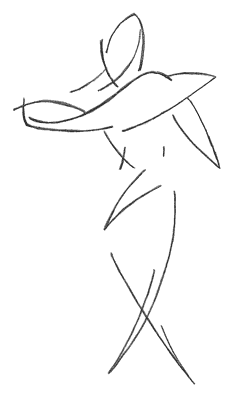
2016 Nov 1
I have found a nice video explaining "Hip-push". It is well known in belly dancing.
There, it is done side-way. In tango, it is the same only done forward and backward. Technically, it is exactly the same way, but there is no side-way visible pelvis movements.
Nowadays, Hip-push is known only by very advanced researchers of Canyengue style, as far as I understand. It is "very african" and allows very short steps where it is felt greatly.
During the very long steps it is not felt, but the mechanism of that still works and allows very long steps done effortlessly.
https://youtu.be/_S5KHLVmq3Y
I have found the "hip-push" phenomena myself during search of the origination of Syncopa rhythm in a body of a dancer.
Once I have found it, I was finally able to understand what was conveyed to me by some tango researchers.
Unfortunately, it is difficult to explain and understand until one to starts doing it and feeling it in her own body.
Hopefully, the way it is done in belly dancing helps in understanding.
I enthusiastically promote the use of hip-push in tango: it is fun, greatly improves technique, helps to move with the small steps not loosing the sense of dance, helps to express syncopa rhythms, and, therefore, it is very tango!
Note on performance: It is not done by "muscles" or "excessive extending of pelvis" ! It is a pure mechanical way of bone movements in the hip-joint. You can even hear "a click" inside of your pelvis! It is heard through the bones.
There is no muscle effort involved, it is totally due to the structure of how our bones are aligned. At the video, the dancer shows physical effort too excessively, it is too much.
Yep, it is belly dancing done with the parter! Do you like it ?
What I mean is better explained here as an "opposite hip-push":
https://youtu.be/6zVRa2pf06c
2016 October 11
To tighten the hips means to tightly press the legs toward each other when one stands. This tenses psoas major and other accompanying muscles (https://en.wikipedia.org/wiki/Psoas_major_muscle, see "addictor'-s). It feels like compression within pelvis and in the inside of thighs. It is easy to achieve when the legs are tight together, but the same tension has to be preserved always, during all steps. This gives stability and a pool of energy readily available. These are the major muscles which pivot a dancer all around, like in the yesterdays class, and for ladies the same. These muscles are trained ( and can be felt ) when doing squats without taking the heals from the floor (important detail ! ).
This is a simplistic advice. In fact we need 1) muscles twisting the pelvis left and right, 2) moving the tail left and right (our tail is not moving, but the muscles are there and they are very powerful, imagine a dinosaur !). These essentially includes all muscles in the pelvis-to-waist and thigh areas. The major thing is that they must work in "twisting" manner, those which twist right then left. Ochos and compact molinetes are the exercises for it. But just keeping the muscles tight like it is explained in the first paragraph gives great results. I do it when I dance. It goes for salon style too when the major source of energy is torso.
2016 May 29
What is art? Art is what affects feelings and generates ideas. Of crowd or just one person, now or in the past.
There is phseudo art. This "art" affects only one feeling: "oh, that is popular (expensive, has history), than it should be good"...
Feeling which is affected, brought to life in your soul, or idea born in your brain under influence of art, does not have to be comprehended by the affected one. Am I clear for you?
2016 March 22
Long time no posts, Facebook takes over..
Here is the video of the demo dance of the last class:
Demo videos are available on the Igor's YouTube channel.
We have made a Facebook page where these videos will be also linked to:
Thank you, and welcome to Igor's tango classes!
2016 April 22
A video explaining hip-bump and other hip related movements: twist, slide...:
https://youtu.be/UpmOsE8yE8A
2016 April 21
It is hard to say, but emotions do not define the dance, therefore they can not be its language.
If you look at the end of my book, there is a diagram of the six pillars of tango:
Or, if you wish, six dimensions:
Rhythm, Space, Movements, Energy, Structure, and Interaction.
Interactions means feelings. ( "Feelings are its language" ).
It is very difficult to say about emotions.
On one hand Argentine tango is emotionless dance. It is meditative dance.
On another hand, tango is a great generator of happiness.
Happiness happens when certain hormones are produced: oxytocin.
Oxytocin is developing with touch, by touch, while hugging, in embrace.
That is why babies need to be touched and cuddled to calm down.
So, we, tango dancers, dancing in close embrace for hours, generate this hormone "on industrial scale", we are literally swimming in these hormones.
Of course, it causes positive emotions.
If you do not know about this mechanism, it seems like unexplained happiness which comes out of nowhere.
The whole surroundings at a tango party facilitates blockage of feeling from outside disturbance as well as from inside one.
With its fancy music, a lot of strange friendly people, comfort, activity.
It takes away from troubles blocking negative emotions, hypnotizing in a good sense.
I have to tell you that modern people live under huge stress which includes everpresent physiological pressure.
Tango and any couple dance in general effectively block it giving its participants a true rest from negative emotions.
2015 July 10
At a regular group class a teacher rely on students who come regularly. She expects most students to know something what she taught before and she may lay down the background for future lessons. This is the time for some drilling exercises. Also, a teacher should create a relaxation atmosphere: people want to have fun.
At a pre-milonga class a teacher should give some immediate tips for the better dancing ( and, is nobody here? try to promote herself ). The most important goal of a pre-milonga class is to beef up atmosphere for the coming milonga party.
At a workshop a teacher should give a more or less complete coverage of a certain topic. This is not a time for excesses, it is time for knowledge. People come to a workshop to learn. The more they learn the better the workshop.
I disagree that the workshop is a good time for practice - it is for after workshop practice. Allocating time for practice after the workshop makes it much more valuable. Also I disagree that the workshop is a time for discussion and feedback. These are waste of time at the workshop and more suitable for a regular group class. However there is another function of a good workshop: people meet new dancers, so encouraging the interaction is good.
Time for discussion and feedback comes when the class was so interesting, that people have got carried away and stayed longer to discuss the things forgetting about time.
2015 June 24
2015: Erin Malley and Doruk Golcu ! Milonga.
2015 March 19
"Масштаб вашей личности определяется величиной проблемы, которая способна вывести вас из себя." Фрейд.
???. ?? ??? ????????? ????????? ?? ???? - ??? ?????????? ?????????. ? ???????? ????????? ????????????, ??????, обдумыванием окружающего ? ????????? ???????? ???????.
2015 Jan 18
When argentinean teachers talk about "intention" as a lead and leading backwards with the back they speak about "Body First" steps, dancing "walking up-hill".
However, it is often very unclear what they mean which causes cofusion to students. "How it is related to "cross-body" then"?
I hope the explanation in my book being systematic brings more light on what is going on and what exact "formula" for all this might be.
There are also "toe-first steps" which are opposite to body-first steps!
2014 Dec 23 We should talk less about Rights, but more about Fairness and Freedom.
2014 Dec 23
Наивные украинцы, во всём слушаясь своего дядю сэма полагают, что за усердие их наградят эмиграцией. Так это и есть general idea - заселить украинцами канаду, а украину - немцами.
Украинцам хорошо. Да и немцам неплохо. Плохо только русским, которые полагают, что украина должна быть заселена украинцами, дружественными россии.
2014 Dec 20
Yeah... the book is very difficult. It is like a mathematical book. Even worse. What can I do :) the logic demanded it.
Every sentence needs thinking and work. It is very compressed. One think follows from another and depend on previous material.
But it is the theory. I definitely should write a simpler book, hopefully eventually I will be able to find time.
Do not hesitate to jump forward. Several chapters are easier and can be understood without much connection to previous material.
While reading, you should try everything many times until the body starts to understand it. It is not possible to progress through the book without practicing. All words are very week in description of human movements. And the goal of my book. It establishes the mathematically solid vocabulary for the complete description of human movements and dance in particular. It is difficult, hey, everything serious is difficult. Have you tried to read Euclid geometry?
By the way did you read other dance books? ( And no one ever written about technique. ). They are very difficult to read, even though the material is much simpler, just describing steps. Too many things are involved. And believe me, it was very difficult to write.
2014 Dec 13
Misty Copeland:
2014 Nov 5
November 22, Saturday, PA JCC Theater.
Semiannual tango party. Live music: Tangonero. DJ: Rene.
8:00-12:00 pm, $15
Two dance floors, dance on stage !
7:15 - 8:00 pm Free tango class: Canyengue. By Igor Polk & Cecilia
5:30 - 7:00 pm $5. Tango Come-And-Share: "Tools of Improvisation". Host Igor Polk. On stage.
Photo (C) Steven He
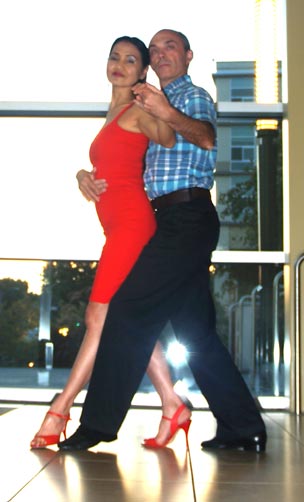 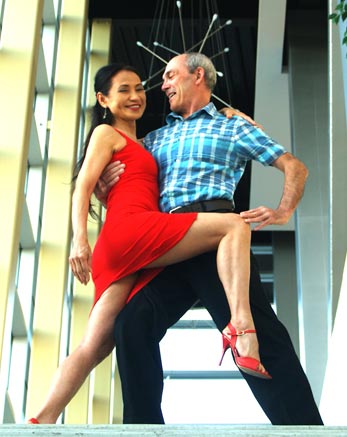 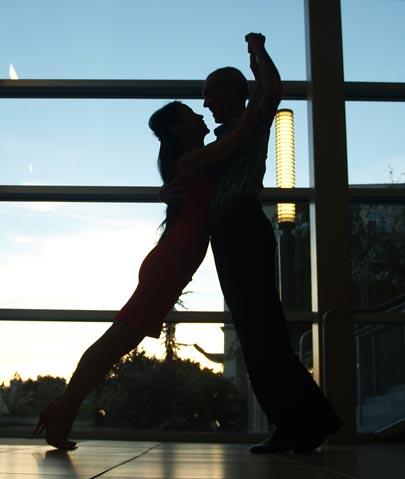 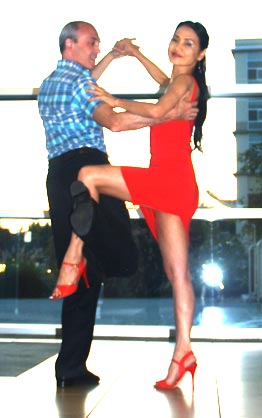 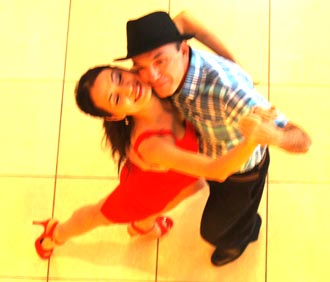 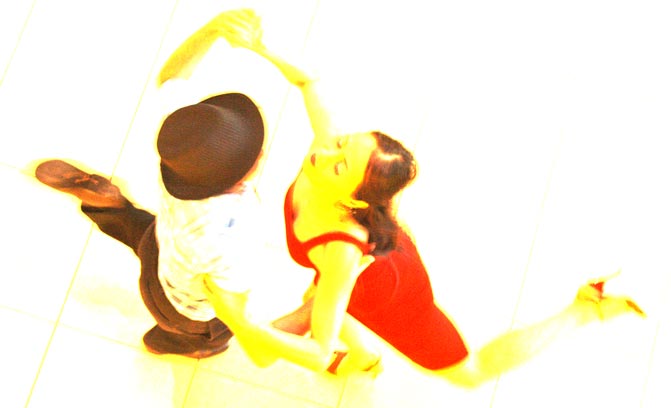 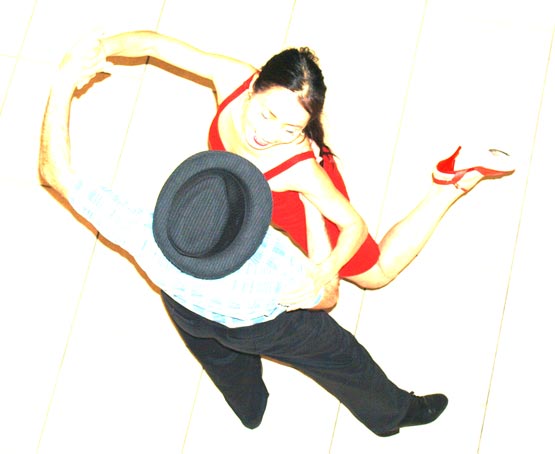 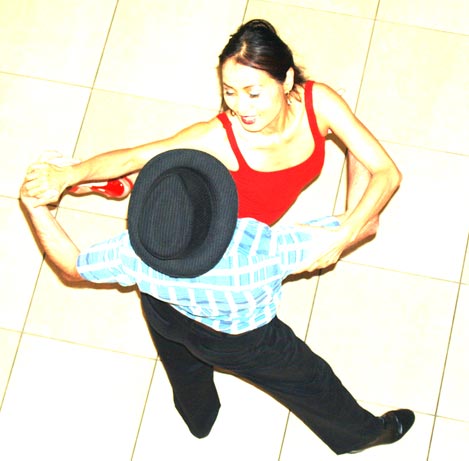 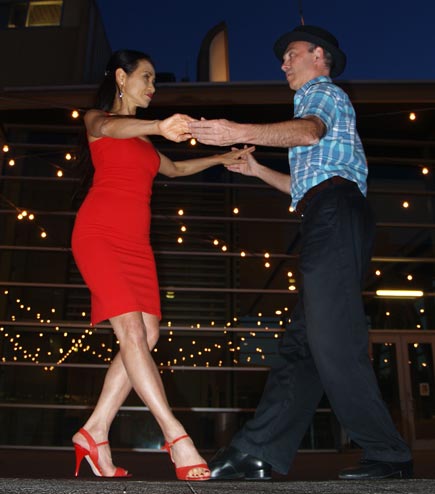
2014 November 12
My goal and NN's goal are different. His goal is to establish here a tango community of social dancers which closely resembles the way of tango life in Buenos Aires.
My goal is to promote creative dancing, the best practices of it.
It is very different. For example, NN would tell that ganchos are "illegal" and wrong to do. I would say that they are a nesessary element.
He would say "High boleos are illegal because they are dangerous on the dance floor". I would say that they are a traditional element of the dance everyone must master. NN would say, during boleos a foot must be on the floor for safety. I say, it must be on the floor because it makes the body of the performer work differently and better, more expressive.
He would say "There is dancing for stage and dancing social", I say "All dancing follow the same rules the same technique or a dancer does not dance right, does not really know the dance".
I have danced with quite many argentineans including pretty famous ones. I do not think they all are examples of the very good dancing. Far from that. One thing is to look at them, another - to feel their dancing. I confidently say that here, in SF, I have met local women with the skills far exceeding the skills of many Argentinean celebrities.
My goal is not to teach how these argentineans are dancing, some of them started their dancing after even me.
My goal is to promote the best dancing I've ever experienced personally myself, restore the dance and research all available styles. And go further. Based on the theory I have developed, based on view on the dance free from any social aberrations, promote the inventive development of the dance, give you the tools, the bricks, the methods how it can be achieved.
And I am correct, since Tango, as all masters whom I respect say, is an improvisational dance. What does that mean. It means not dancing as everyone else. It is opposite to "dance like everyone else". The best dancers dance like no one else. Every master strives for his own style and does not want to look like someone else.
I am trying to convey the principles of building a personal style while staying within the boundaries of traditional tango and beyond.
2014 Nov 3
From a conversation: "... If this was true, then someone could have a stroke and lose their sense of rhythm. This has never happened. There are several tests for beat-deafness and nobody has been found who cannot find the beat. This is just an excuse made by people who don't know how to teach and confused students who are mistaught.
I've taught rhythm for years, and I promise you that your friend knows how to access it. It is there for you as well, but you are probably looking outside your body. This won't work. You can't follow anyone or anything for rhythm. You must find it inside..."
2014 Nov 2
I have met recently quite a few publications that "Performance reviews in general are outdated and pointless". This is not so. Let me give you my view why they are important FOR YOU!
Companies and projects come and go. Bosses come and go. A performance review is an official document, only document, which testifies about your achievements and qualities. If you do not have a review at your job you should demand them!
I had several reviews in my professional life and all of them served me greatly later. I am very thankful to my managers who took time and care to prepare them.
If you do not have a review you are at a total mercy of a your superiors in all promotion decisions. If you have a review, you have some argument which can be useful if a situation at job is changing. Demand reviews !
2014 Nov 7
Европа прощай? Россия это и есть Европа. Второй её полюс. Первый, с победой английского флота над испанским в 16 веке - Англия. Россия развивалась на восток, в Сибирь, а Англия, к её счастью, на запад, в тёплую америку. Германия, Польша и все остальные болтаются между двумя этоми полюсами. И этого никак не изменить и этим объясняется вся политика на протяжении столетий и будет объясняться.
..Да культура только начинает возраждаться после смутного времени Горбачёва и Ельцина.
А насчёт того, что Россия это "сущая азия", что то мне вам сказать.. Жил я в Белоруссии. Я работал лаборантом в Новополоцком Политехническом институте. Потом поступил в Минский Радотехнический Институт. Потом работал, в том числе в Минском Медицинском Институте. Так вот, все преподаватели и работники этих институтов, а если не они, то их преподаватели получили образование в России.
... А насчёт Азии...недавно один китаец меня спрашивал, а много ли американских преподавателей было у меня когда я учился. Когда я сказал, что ни одного, он посмотрел на меня очень странно. Чувствую, не верит. И уязвлён.
2014 Oct 24
IndieReader has published a review on my book. Three stars !
"
The book is laid out with specific instructions on origins of the movements that a dancer must master in order to effectively dance the Argentine Tango. There are also detailed descriptions of poses and steps that when paired together can create a wonderful dance
" "
Polk is able to successfully explain ... intricate steps because of the immense detail he provides "
" Polk's book [is] a huge help for instructors "
Since the book is full with grammar errors I would add one more star :) Don't you agree?
http://indiereader.com/2014/10/twisted-body-dance-theory-argentine-tango/
IndieReader provides INDEPENDENT anonymous reviews by the topic experts. An author has no influence on the outcome whatsoever.
2014 Oct 24
Piano Performance, Liszt, Companella, Sofya Gulyak ( Софья Гуляк )
2014 Oct 23 Visualization of rhythms: http://youtu.be/2UphAzryVpY. Check their tango presentation.
2014 Oct 8
New article: Three ways to make a Forward Pivot and how it is used in
Several Figures of Forward Ochos
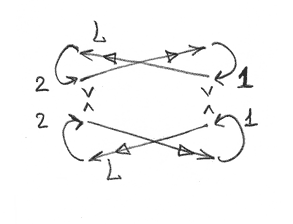
2014 Oct 8
New video:
2014 Oct 4
A wokshop at a community dance club in San Jose:
"
Thank you for the great lesson we had from you today, especially on such a late notice. We shall keep in touch and arrange for more "
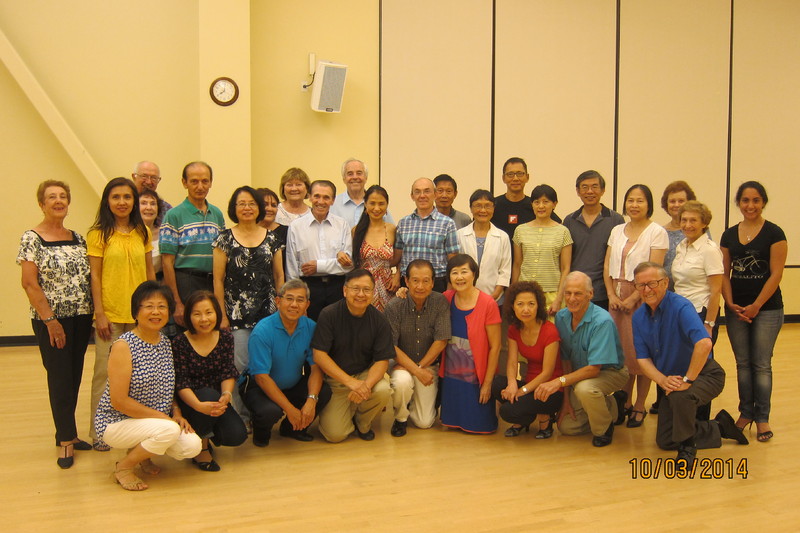
2015 Sept 15
A workshop is coming at the DanceBoulevard:
1. Basic Figures for Social Tango
2. Tango Turns and Other Elements of Modern Tango
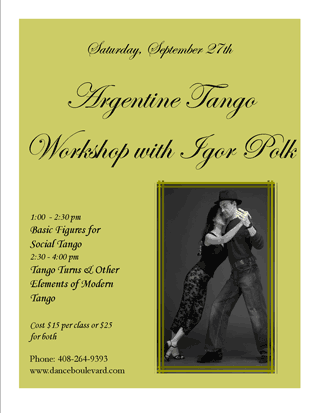
The first workshop was absolutelly fabulous !!!
The second one was useful, but a little complex for the dancers. People need more practice for the turns! We also practiced close embrace tango walk, a real one, and forward ochos and boleos.
2014 Sept 09
Some fresh photos by Steven He:
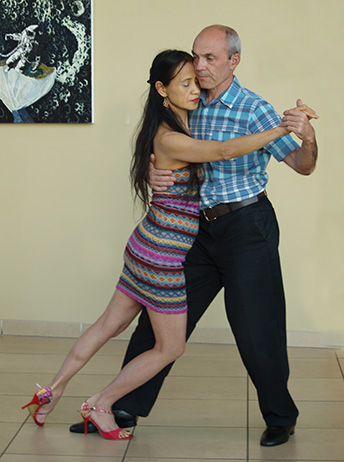
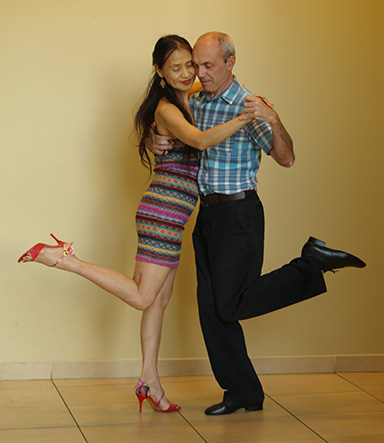
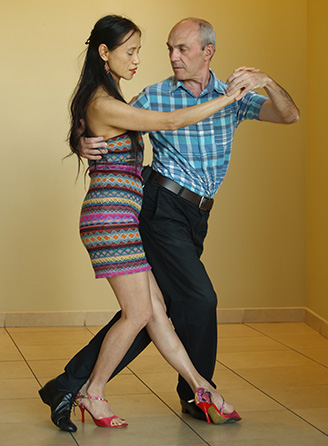
2014 Sept 7
Dear Dancers,
I have lost the original mailing list, so if you want to receive update messages from me, please, let me know: ipolk@virtuar.com
2014 Aug 28
http://youtu.be/uRZaj443zAQ - new video of our class material. I do not like they way we are dancing. but I'll keep it here for the reference of the figures.
2014 Aut 22
Contra-body boleo
So called "contra-body boleo" or just a contra boleo is a popular figure. In the past, around 2000 I have met it at tango nuevo lessons. Now it is taught at milonguero and salon style classes as well. Some kind them works in close embrace very nicely.
There is well felt difference between regular boleo and contra-body boleo. As a regular boleo, contra-body boleo can be both behind and in-front. As an excellent visual example, I'd like to refer to the Homer and Cristina Ladas video on boleos. Almost all boleos here are contra-body.
Here is a simple explanation how it is done on example of boleo behind when a woman is on her right leg. After a back pivot like in back ochos and when her leg is already extended preparing for a step or after a regular slow boleo when her leg is behind her, a man with his torso goes around a woman's axis to his left (it means clock-wise) provoking her to charge more and therefore producing an energetic, deep movement of the leg to her left.
The key points here are: 1) Geometry: A man "Goes around" her. Not a slightest distance away, but perfectly around; 2) Timing: He starts movement to the his left (her right), leading contra-boleo when her leg just finished the extension. 3) Response: a man while going around her is provoking her to charge her body toward him (to her right) more. However for the best result she should keep facing him with her torso actively, it means turning toward him herself. It is her body performing the figure not his. Often women do not do it and that prevents the figure from happening.
After a man went around her no more no less than needed, he leads her a regular "boleo return".
The common mistake in learning this element besides a man "not going perfectly around" is that a woman is "too hasty". If instead of nice extension of the leg, slow, juicy movement, awareness and enjoyment of her leg she just falls back this not going to work.
Now let me show you what is happening during "contra-body boleo" from the point of view of "Twisted Body" dance theory.
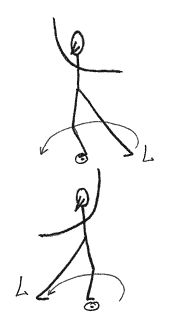 - Here, on the left, a process of preparation is shown. It is the first two phases of a regular back boleo. On the top, let us call it 1), a woman starts moving the leg back. Because a man leads it, of course. How - this is beyond the current topic. On the lower picture (2), she is in a "ready" position: her leg is extended, she is on her standing leg well balanced. If instead of boleo she would do a pivot without boleo, it is exactly the same. - Here, on the left, a process of preparation is shown. It is the first two phases of a regular back boleo. On the top, let us call it 1), a woman starts moving the leg back. Because a man leads it, of course. How - this is beyond the current topic. On the lower picture (2), she is in a "ready" position: her leg is extended, she is on her standing leg well balanced. If instead of boleo she would do a pivot without boleo, it is exactly the same.
Changing between 1) and 2) produces a regular boleo. At this moment a man will start moving around her to the left, she will turn more toward him, charging the body more, and finally performing the leg return with more energy. I want to mention that for the performance of the element a man is not necessary, a woman is able to make it alone. That is why for the sake of saving space, I will show only the woman's part.
On the picture below, you can see the diagrams of body part positions for pelvis, lower torso and upper torso. For the explanation, see here. From 2) when a man goes around to her right, she "twists" her lower torso toward the man as it is shown on 3). This produces overcharged twist in the body: both lower and upper torso are "twisted" to the right, and therefore release to 1) is significantly more powerful. Oh, that feels good !
These diagrams help to understand what is going on in the body. The lower torso plays the crucial role. "Twisting" does not mean there can be actual movement, not necessarily. It can be just a tork.
There are at 4 types of contra boleos on each leg. I have described one of them, other are done is a similar way. |
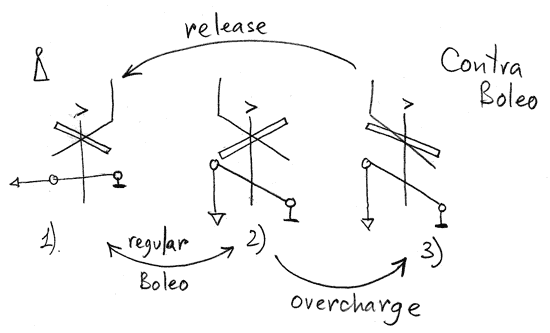 |
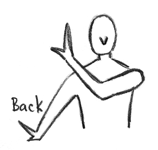 To practice overtwisted body, you can use this pose. To practice overtwisted body, you can use this pose.
2014 Aug 19
A colleague of mine from Italy, Enrico Massetti has made wonderful jewelry for tango dancers.
Check it out! http://tango-adornos.com/ipca-tango-adornos-coupon-gift-code/
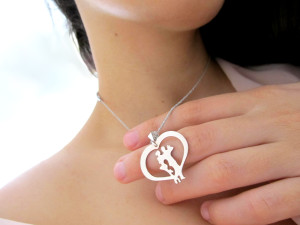
2014 June 23
From one blog:
"I am strong: I know my strengths;
I am worthy: I know when, in what, and for whom I am very useful;
I am beautiful: (well. that is for women..) YOU are !
I am perfect in something ( which I know of what ). And the rest does not matter much;
I am surrounded by many people some of whom can help me, some of whom can support me. I know how to be friendly. I am different with everyone. I am tall, because I am standing on the shoulders of giants, and I study from them..
I am me because I realize my strengths, worth, beauty and perfection, and I have support of my friends and relatives, and I slowly but surely go in the direction which I feel is the best for me."
( yes, yes, I wrote it, but it is for someone else ).
2014 June 19
Posture:
2014 June 10
Yesterday I have taught in one single beginner's class to several first-time students: pseudo-left turn, right turn, going to cross, ocho-cortado. This is my personal record.
I'll tell you more theory about it, why it came together nicely.
1. Pseudo-left turn ( Corte-y-Quebrada two times which can be done turning left) has the rhythm 1-2-3, 1-2. Two times: 1-2-3, 1-2, 1-2-3, 1-2 or 3 measures)
2. Right turn, even in its simple form, has the same rhythm: 1-2-3, 1-2. Two times: 1-2-3, 1-2, 1-2-3, 1-2, or 3 measures.
3. Going to cross after Corte-y-Quebrada ( continuously), together with it, this is a turning figure to the left, has the rhythm 1-2-3, 1-2-3, or two measures.
4. Ocho Cortado, which includes Corte ( Arrepentida) has the rhythm 1-2-3, 1-2-3, or two measures.
5. All these figures have interchangeable parts matching together.
6. That is why it was all possible.
7. As you can see 1. and 2. has the same rhythmical structure, but 1 is to the left, 2 is to the right. 1. cuts the turn, 2 makes a continuous turn.
8. And 3 and 4 has the same rhythmical structure, but 3 is to the left, 4 is to the right ( of a man). 3 makes continuous turn, 4 cuts the turn.
9. It all forms a very symmetrical mathematical structure ! Everything fits so nicely, and just asking to be in one lesson.
Note: 1-2-3 means roughly: three steps on 1,2, 3, and pause on 4.
2014 May 30
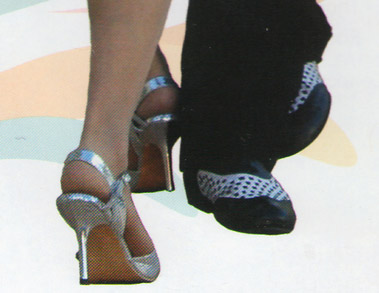
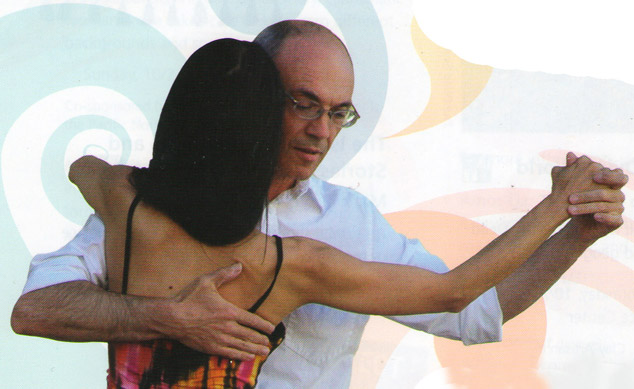
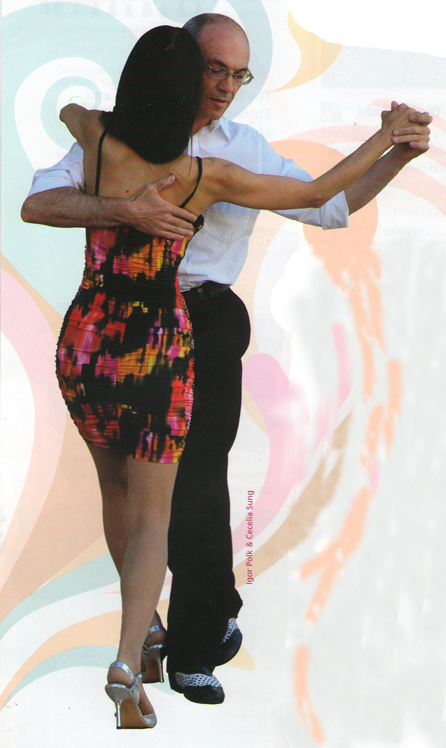
2014 May 29 Tango steps is a complex art and science ( link ). What would be the most useful brief advice how to make a back tango step? Press a hip joint of the free leg toward the partner as a preparation to the step.
2014 May 28 To lead is to make a woman feel like she is dancing.
2014, May 20
Where is in the book the explanation how pelvis area is used in balance?
See the chapter about pelvis, hips, “Origins of movements in Pelvis Region” is at the very beginning.
It explains that there is twist of the pelvis itself and another one of a Tail. “The tail” concept is really powerful. The tail can be “twisted” in both directions independently of twist of the pelvis, and therefore greatly variating it applications. The “twist” there is imaginable, it is an abstract concept. Our actual tail does not move. But muscles are still there. They work. They are very strong. I like to compare our little “was a tail” with a powerful dinosaur tail. It suits tango perfectly.
Just saying “tight the bottom” works, but it is not enough. How to use it? Combinations of pelvis and the tail “twists” provide vocabulary for creating new movements.
Move your tail!
Once the bottom part is tight, particularly, “twisted”, the balance is very good and the upper torso is being freed for free movements.
Torso is important for balancing too. Good use of torso, rib cage, and muscles connected there provide wonderful balanced movements. One has to feel “stretch in the lower rib cage”.
2014, May 19
Second edition of my argentine tango dance theory book is updated with
- Case Study: 8-Count Basic
- 8-Count Basic, the First Way, Salon
- Salida
- Transition to prepare for 3-Step-to-Cross done with Boleo Turning 90° Left
- How to Lead Boleo to the Left
- Transition to Prepare for the 3-Step-to-Cross in a "Regular Way"
- What is Cross
- Going to Cross from Side-Position on the Same Leg
- 3-Step-to-Cross
- Transition from Cross preparing for Resolution
- Resolution
- "8-Body-Twists" Basic
- Step Diagram of the 8-Count Basic done with Boleo Turning 90° Left
- Step Diagram for the 8-Count Basic with the Preparation for 3-Step-to-Cross done in the "Regular Way"
- Step Diagram of the 8-Count Basic done in a Rectangular Way
- Step Diagram of the 8-Count Basic Done in a Most Unusual Way
- Timing and Rhythmic Feel and Variations
- Common and not so Common Improvisations
- Apilado Notes
- Obtaining the Stage 4 Pose with Glued Feet Pattern Generator
- 8-Count Basic with the Circular 3-Step-to-Cross
- 8-Count Basic with a Foot Change done simply. "Cross Basic"
- 8-Count Basic, the Second Way, Orillero
- "Open Body to Cross Body" vs. "Side, Foot Change to Cross Body"
- "Opposite Barrida to Cross and to Liberty" vs. "Opposite Barrida to Parada"
- "Side, Foot Change, and to Parada" vs. "Side, Foot Change, and to Liberty"
- Inserting Cross into Milonga Box. The Third Way of 8-Count
- Unwinding 8-Count Basic in a Line
- Milonga Box Resolution in Line
- Boleo with the Redirection to Left Going Around the Woman
- Man's Opposite Parada in Promenade Pose
- Making 8-Count Basic with Turning to the Left Twice
- How to Lead Her to Forward Step Instead of Cross. Continuation of the Circular 3-Step-to-Cross into the Second Half-Turn ending with Boleo with the Redirection to Left
This part is not available on line.
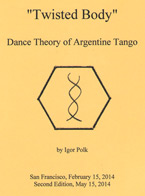
To get the book in print, contact the webmaster
$24.99, 102 pages, 152 drawings, 8.5x11, $4 mailing
in US, $12 mailing to Europe
2014 April 24
Here is the video of a group performance at the event (patio with the fabulous view is on the left, on the right is the stage for musician, all spectators are behind):
SF Bay Area ATUSA Championship contestants - "Nada" - at Palo Alto JCC, another angle: Published on May 19, 2014 Argentine Tango Salon Style Demo by SF Bay Area ATUSA Contestants @JCC Palo Alto, May 2014 Music- "Nada" by Di Sarli;
and here is the performance of 2014 Salon Tango campions Nicholas and Stephanie. Vida querida" - at Palo Alto JCC
This was the best feeling event of all our parties. Thank you everyone !
* * *
On May 17, Saturday, we are going to have an annual tango party at Palo Alto Jewish Community Center. We already had a party around the New Year, so it turned out to be a semi-annual party.
Musicians: quintet Redwood Tango Ensemble
DJ Paul Vladimirsky
8:15-12:00 - Dance party
7:30 - 8:15 - Introductory tango lesson
Location: "Cultural Arts Hall" ( the theater ).
Two dance floors: dance on stage! Potluck. Coffee and tea provided. Link
Before the party, Igor Polk will present his tango book:
5:30 - 7:00 - "Twisted Body Dance Theory of Argentine Tango".
Location: on stage. This is a tango workshop. Free.
Igor will present the main concepts, show how they fill the puzzle of tango and answer questions.
The book is about how tango figures and elements are formed, why they are the way they are, why there is ambiguity in tango teaching, what is the difference between styles, what is leading and following, how to improvise, what is tango rhythm, how to dance with energy.
The book is very technical, in condensed language, with numerous illustrations. 118 pages.
Preliminary acquaintance with the text is advised:
http://www.virtuar.com/tango/theory/tb0.htm
The book will be available for sale, $20
2014 May 12
The Verdi Club Milonga on Thursday will end this month . .
After an 18 year successful weekly run (!), San Francisco's Thursday night milonga, The Verdi Club Milonga will unfortunately be closing at the end of May. It will be replaced by (a much higher rent-paying) Salsa night starting in June. Christy Cote and Víctor Meneses started the milonga on July 4th 1996 and Christy and Adolfo have been running the milonga since 2007.
With only three Thursdays left, make sure to take part in this farewell. Trio Garufa will be playing this week, and Seth's sextet will be playing on the last Thursday.
As a side note, you might be interested to know that this is a result of what has been happening in S.F. with the exploding demand for real estate. As locals probably know, many large dance spaces have closed or will be closing soon like Vima Dance (a space that was considered as a back up location to the Verdi Club until they lost their lease), Cocomo (closing soon but reportedly has a new space in SF), Cell Space (closing at the end of 2014. The milonga plans to find a new home). The space where El Arrabal is held has been sold...actually 1/2 the building was sold...a new ballroom is planned for in the other half of the building before the end of this year but in the meantime El Arrabal with not be happening. To sum it up, the current tech boom is making tango move out of the city. Will the boom last for 18 years?
2014 May 08
A friend said to me: "I know what makes the new World Tango Champions. The follower executes every movement with perfection. She uses the floor better than any tango dancer I have seen to this date. She has the floor moving up her body through the top of her head with power. She is not lacking in energy in every execution. Every muscle in her body is working. Her whole attention is given to every moment. Because of this, the lead is most likely there also. But I could not keep my eyes off of her. She demanded attention."
2014 April 21
Wow ! The US tango competition was a real blast this year ! Amazing experience !
2014 April 20
Our dance ( Cecilia is in white-red dress, I am in black ). Day 1, round 4, song 1. We have made 10 turns of different kinds, forward and back ochos during the first 1.5 minutes we were recorded. Song 2.
2014 April 16
Laban notation does not take in account the technique. It is only visual. The good thing is that it is suitable for any style of dance. But at the same time it makes the record very cumbersome, overweighed, and difficult to read for a dancers.
My notation is a shorthand of my technique. It has graphical and symbolic form, and is actually very short. Graphical form is easier to understand, but symbolic is also not difficult ( and it is shorter ). More important is that the symbolic form allows to present “transition”, i.e. mechanics of dance figures. Of course, it is all related to Argentine Tango only, but I feel it can be used in other places where appropriate.
Do not pay attention to symbolic formulas, just skip it. Graphical formulas are more useful. Video will never be able to replace abbreviation, it is not abstract enough, many things are just not visible. My abbreviations show what happens inside the body, other abbreviations – only what is visible.
2014 April 15
Very mistaken are those who think that the dance must contain elements of great physical abilities. Large theatrical movement, kama-sutra poses, rabbit-fast steps is not what defines a dance. All this belong to a totally different area: manipulation of spectators to program their mind in a certian way. A dance is defined by correct body postures ( 14 of them on one leg), variety of perfect rhythms, combination of steps into figures, adaptation to a dance partner and environment, inventiveness, musicality, feeling, enjoyment of movements to music and in community. All that is available to any average people. The conclusion is that everyone can dance well !
2014 April 2
Javier Rodriguez and Virginia Pandolfi Tango and Milonga:
2014 April 2
About “breaking down preconceived idea about tango”. It goes in two directions. One is innovation. I mean innovation in usual terms, another one is going to very basis. It is my direction. It serves innovation, because it discovers very basic and therefore powerful mechanisms of generation of all available moves, figures, and dances. It goes well beyond the usual established thinking. That is what my book's most important result. And that is what you going to get studying it. Not just “new” ways, but ALL ways! This is what mathematical approach gives. Think about it. It is overwhelming?
2014 April 1
https://www.youtube.com/watch?v=KDhpSB1Ao8w ( not tango:
Final Fantasy Dance Battle
)
2014 March 12
How to make tango friends for a woman. Valuable friends.
On the way in doing this, do not ask others for dance unless you are a master. Look approachable, but not insisting. Do not sit in a corner. Be communicative, but do not spend time talking. This averts. Watch other dancers and do so with a pleasant, approving, open face, it attracts. Dance well with whoever invites you. And go to workshops where more advanced students go, that is the way to secure friends. Good leaders observe dancing couples and choose whom to invite by observation, this is true. Well, that is only if they are looking for a new partner, have no friends in line to dance with. The most valuable is elegance, axis, ability to follow, good spirit. On your face an enjoyment of dancing must be read. This is important and attractive. The most advanced dancers will look at the feet and quality of turns. Tricks attract clowns. No adornments, god save you from this! The best time to get to new partners at the beginning and at the end of milonga, when there are less people. Also less popular events, where there are fewer people serve well as meeting grounds. Wear attractive dress. Sexy, yes, it does work. But elegant and tasteful. The cloth has to be pleasant on touch, not slippery, not rough.
The paramount is quality dancing. This ultimately defines everything.
2014 March 03
Here is a new figure. For the terms, abbreviations, and technique of individual elements, please visit "Twisted Body" Dance Theory; For questions.
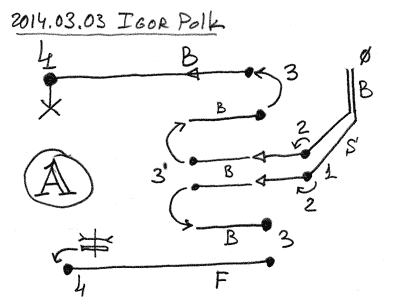 The figure A. This is a variation on 8-count basic. It introduces back ocho for a man and a woman on step 3. To the best of my mind this figure was taught be Puppy Castello and presented here, in San Francisco, by Graciela Gonzales. Stages of the figure: The figure A. This is a variation on 8-count basic. It introduces back ocho for a man and a woman on step 3. To the best of my mind this figure was taught be Puppy Castello and presented here, in San Francisco, by Graciela Gonzales. Stages of the figure:
- 0. Starting position. On the diagram, man is below, women above;
- 1. Back-side move for both partners like in regular 8-count basic;
- 2. Pivot backward for for both partners. It can be done with a boleo; Then step. It is done in the direction of the previous side step, to the left of the picture;
- 3`. One more pivot back for both partners;
- 3. The man is leading woman to pivot back, but he does not do it himself. After her pivot they are in a regular 8-count basic position for a three-step to cross;
- 4. Three step to cross.
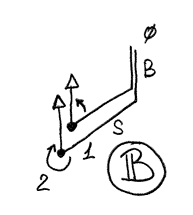 There are variations. One was shown by Gavito while he was in Redwood City invited by Cristy Cote. It is when a man does not pivot back on 2, makes a forward third step instead of the back, but leading a woman to back pivot on 3'. There are variations. One was shown by Gavito while he was in Redwood City invited by Cristy Cote. It is when a man does not pivot back on 2, makes a forward third step instead of the back, but leading a woman to back pivot on 3'.
On the picture B there is a variation, when the man makes a very deep pivot, and a woman makes it very small, essentially just repositioning her body. Then everything is like in A, but the direction of the third step is like on the picture B. |
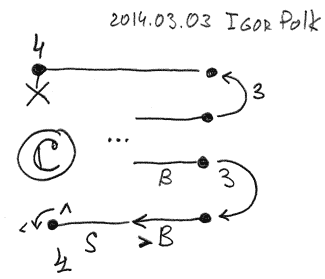 Here is a new figure, on picture C. The transition 2 is done like on A or B. On 3 a man makes a back pivot too and steps backward (!) leading a woman to a regular three-step to cross. He steps backward in forward direction. A man makes himself back and side steps and after the side one, fixes the direction of his face forward, like in the regular 8-count. Fancy ! Here is a new figure, on picture C. The transition 2 is done like on A or B. On 3 a man makes a back pivot too and steps backward (!) leading a woman to a regular three-step to cross. He steps backward in forward direction. A man makes himself back and side steps and after the side one, fixes the direction of his face forward, like in the regular 8-count. Fancy !
|
2014 February 21
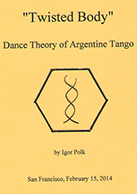 "Twisted Body" Dance Theory is published online. Welcome to read it. Leave your comments at the discussion forum, Google+, or Facebook. You can e-mail directly to me. "Twisted Body" Dance Theory is published online. Welcome to read it. Leave your comments at the discussion forum, Google+, or Facebook. You can e-mail directly to me.
Computerized dance: Nobuyuki Hanabusa;
I think it would be better if dancers controlled lights..
2014 January 21
Oops, 2014 already, I should start a new page...
Here are some gems. Maestros
Carlos Gavito y Natalia Hills
Orlando Paiva
2014 March 01
Донецк; Харьков; Одесса;
2014 Feb 27
I prosto stihi
-
Не знаю, откуда стырено. Копирайт отсутствует.
Путин: А у нас в России газ! А у Вас?
Янукович: А у нас переворот, вот.
Лукашенко: А у нас одна картошка,
но у нас ее так множко, что нам пофигу ваш газ!
Никакой переворот не допустит наш народ! Вот!
Путин: А у нас Олимпиада! Что еще для счастья надо?
И ликует весь народ! Вот!
Янукович: А у нас переворот. Вот!
Лукашенко: А зато у нас в стране, благодаря, конечно, мне
нет ни бедных ни богатых. Все живут лишь на зарплату.
Путин: А у нас на лыжах в Сочи, каждый может отдыхать
И чиновник и рабочий, вот такая благодать!
Янукович: А у нас переворот! Вот!
Обама: Ну, а мне вообще все страны,
шлют картошку, газ, бананы.
Кто бананы не пришлет, у того и переворот! Вот!
2014 Mar 1
|
 Guitar sight reading, note memorization. Start with C Major scale
Guitar sight reading, note memorization. Start with C Major scale  https://www.paloaltoonline.com/news/2010/06/21/dancing-the-night-away
https://www.paloaltoonline.com/news/2010/06/21/dancing-the-night-away

 Mayumix Botanical Design featuring botanical printed (or eco printed) scarves
Mayumix Botanical Design featuring botanical printed (or eco printed) scarves




















 - Here, on the left, a process of preparation is shown. It is the first two phases of a regular back boleo. On the top, let us call it 1), a woman starts moving the leg back. Because a man leads it, of course. How - this is beyond the current topic. On the lower picture (2), she is in a "ready" position: her leg is extended, she is on her standing leg well balanced. If instead of boleo she would do a pivot without boleo, it is exactly the same.
- Here, on the left, a process of preparation is shown. It is the first two phases of a regular back boleo. On the top, let us call it 1), a woman starts moving the leg back. Because a man leads it, of course. How - this is beyond the current topic. On the lower picture (2), she is in a "ready" position: her leg is extended, she is on her standing leg well balanced. If instead of boleo she would do a pivot without boleo, it is exactly the same. 
 To practice overtwisted body, you can use this pose.
To practice overtwisted body, you can use this pose. 




 The figure A. This is a variation on 8-count basic. It introduces back ocho for a man and a woman on step 3. To the best of my mind this figure was taught be Puppy Castello and presented here, in San Francisco, by Graciela Gonzales. Stages of the figure:
The figure A. This is a variation on 8-count basic. It introduces back ocho for a man and a woman on step 3. To the best of my mind this figure was taught be Puppy Castello and presented here, in San Francisco, by Graciela Gonzales. Stages of the figure: There are variations. One was shown by Gavito while he was in Redwood City invited by Cristy Cote. It is when a man does not pivot back on 2, makes a forward third step instead of the back, but leading a woman to back pivot on 3'.
There are variations. One was shown by Gavito while he was in Redwood City invited by Cristy Cote. It is when a man does not pivot back on 2, makes a forward third step instead of the back, but leading a woman to back pivot on 3'.  Here is a new figure, on picture C. The transition 2 is done like on A or B. On 3 a man makes a back pivot too and steps backward (!) leading a woman to a regular three-step to cross. He steps backward in forward direction. A man makes himself back and side steps and after the side one, fixes the direction of his face forward, like in the regular 8-count. Fancy !
Here is a new figure, on picture C. The transition 2 is done like on A or B. On 3 a man makes a back pivot too and steps backward (!) leading a woman to a regular three-step to cross. He steps backward in forward direction. A man makes himself back and side steps and after the side one, fixes the direction of his face forward, like in the regular 8-count. Fancy ! 
